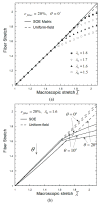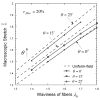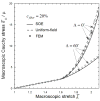A Micromechanics Finite-Strain Constitutive Model of Fibrous Tissue
- PMID: 21927506
- PMCID: PMC3171755
- DOI: 10.1016/j.jmps.2011.05.012
A Micromechanics Finite-Strain Constitutive Model of Fibrous Tissue
Abstract
Biological tissues have unique mechanical properties due to the wavy fibrous collagen and elastin microstructure. In inflation, a vessel easily distends under low pressure but becomes stiffer when the fibers are straightened to take up the load. The current microstructural models of blood vessels assume affine deformation; i.e., the deformation of each fiber is assumed to be identical to the macroscopic deformation of the tissue. This uniform-field (UF) assumption leads to the macroscopic (or effective) strain energy of the tissue that is the volumetric sum of the contributions of the tissue components. Here, a micromechanics-based constitutive model of fibrous tissue is developed to remove the affine assumption and to take into consideration the heterogeneous interactions between the fibers and the ground substance. The development is based on the framework of a recently developed second-order homogenization theory, and takes into account the waviness, orientations, and spatial distribution of the fibers, as well as the material nonlinearity at finite-strain deformation. In an illustrative simulation, the predictions of the macroscopic stress-strain relation, and the statistical deformation of the fibers are compared to the UF model, as well as finite-element (FE) simulation. Our predictions agree well with the FE results, while the UF predictions significantly overestimate. The effects of fiber distribution and waviness on the macroscopic stress-strain relation are also investigated. The present mathematical model may serves as a foundation for native as well as for engineered tissues and biomaterials.
Figures







References
-
- Annovazzi L, Genna F. An engineering, multiscale constitutive model for fiber-forming collagen in tension. J Biomed Mater Res Part A. 2010;92(1):254–266. - PubMed
-
- Azuma T, Hasegawa M. A rheological approach to the architecture of arterial walls. Japan J Physiol. 1971;21:37–47. - PubMed
-
- Azuma T, Oka S. Mechanical equilibrium of blood vessel walls. Am J Physiol. 1971;221:1310. - PubMed
-
- Brown IA. A scanning electron microscope study of the effect of uniaxial tension on human skin. Br J Dermatol. 1973;89:383–93. - PubMed
-
- Chuong CJ, Fung YC. Three-dimensional stress distribution in arteries. ASME J Biomech Eng. 1983;105:268–274. - PubMed
Grants and funding
LinkOut - more resources
Full Text Sources
